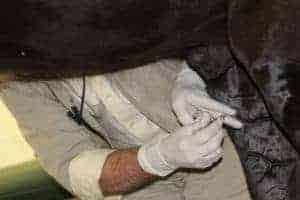2019 American Association of Equine Practitioners Convention Coverage
Read the latest in equine health research, news, and information presented at the 65th Annual AAEP convention in Denver, Colorado
Each year The Horse’s team of staff and reporters attend the American Association of Equine Practitioners’ (AAEP) Convention, which is the world’s largest gathering devoted to horse health. This year nearly 6,000 equine veterinarians, researchers, students, and industry professionals attended the event, held Dec. 7-11, in Denver, Colorado. Attendees gained access to 137.5 hours of continuing education across all aspects of equine medicine, including digestive health, colic, reproduction, wound care, and much more. The following articles include our in-depth AAEP convention lecture coverage from 2019. (Keep checking back as we update this page with content!)
Section Title

Inhaled Ciclesonide: Potential Help for Asthmatic Horses
Study: This corticosteroid was effective for treating horses with asthma and produced fewer side effects than current options.

Antimicrobial-Impregnated Gauze Helps Equine Wounds Heal
Using 0.2% PHMB-impregnated gauze reduced the growth of underlying bacteria commonly implicated in orthopedic wounds and infections of horses.

Using Stride Parameters to Prevent Racing Injuries
Stride changes during races and works could help identify horses at risk of impending injury.

Old Horses Aren’t at Higher Risk of Reflux Post-Colic Surgery
Penn Vet researchers found older horses with small intestinal lesions that survive colic surgery are just as likely as younger horses to develop postoperative reflux or to survive to hospital discharge.

Reconsider Amikacin at Reduced Doses for Joint Injections
Study: Amikacin is indeed toxic to cartilage, synovial cells, and stem cells. When used preventively for joint injections, lower doses are likely warranted.

Heads or Tails? Anesthesiologist Finds New Route to Sedating Horses
Administering detomidine gel to mares intravaginally might be easier and more effective than giving it intravenously.

Novel Treatment for Ocular Squamous Cell Carcinoma Looks Promising
Veterinarians successfully used a treatment option from human medicine to reduce squamous cell carcinomas in horses’ eyes.

Equine Influenza Cases on the Rise, Even in Vaccinated Horses
Adult horses are at greatest risk of infection in late winter and early spring.

Polyacrylamide Hydrogel: An Alternative Osteoarthritis Treatment Option
Pilot study: 82% of unsound racehorses with osteoarthritis treated with 2.5% PAAG joint injections showed no signs of lameness six weeks after treatment.

2-in-1 Suspensory Desmitis Surgery Restores Western Performance Horses
A deep branch lateral plantar neurectomy and fasciotomy procedure can get affected horses back to work.

Inhaling Fungi Increases Horses’ Risk of Inflammatory Airway Disease
Management strategies include inhaled corticosteroids and environmental changes such as steaming hay.

How to Measure Horses’ Rehabilitation Progress Objectively
Seven measurement tools and methods veterinarians can implement into equine rehabilitation programs to track progress.

Commercial Equine In Vitro Embryo Production: What to Expect
Factors that contribute to a breeder’s likelihood of getting a live foal using intracytoplasmic sperm injection.

Genetic Testing Options for Horses
Two leading genetics researchers described current and upcoming tests for a variety of heritable equine conditions.

Top Equine Repro Studies of 2019
Dr. Regina Turner shared her favorite breeding-related studies on topics ranging from foaling prediction to estrus suppression.

12 Fracture Repair Take-Homes From a Top Equine Surgeon
Dr. Dean Richardson presented the Milne State of the Art Lecture at the 2019 American Association of Equine Practitioners’ Convention to offer insight into treating bone breaks and fractures in horses.
Brought to you by:






